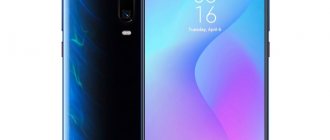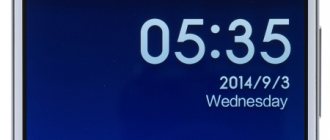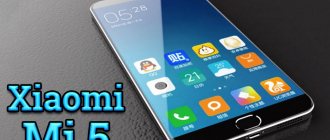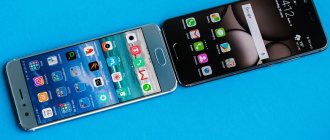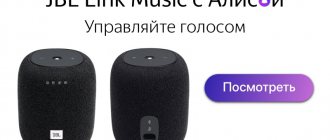Design and ease of use
The Xiaomi Redmi Note 3 Pro version has a non-separable body made of metal with minor plastic inserts - their color design and texture are similar to the main coating. In addition to aesthetics, they also have a functional significance, ensuring the normal functioning of existing antennas.
The top edge is filled with a headset jack, a noise-canceling microphone and an IR port. At the bottom there is a main microphone and a micro-USB port. The left side contains a slot for installing SIM cards, while on the right there is a volume control and a power button. The system buttons are touch-sensitive; they are displayed on the screen and do not take up any useful space from it.
The reverse side contains a fingerprint scanner, flash and main camera. None of the elements extend beyond the body, which, if not completely eliminates their damage, then reduces it to a minimum.
The assembly is solid, there is no play or creaking of individual components. As for ergonomics, it is implemented at a high level - the device fits perfectly in the hand and does not cause even the slightest discomfort during use.
Results (pros and cons)
The Xiaomi Redmi 3 Pro smartphone has performed well in China, as well as in Russia and other countries. This is an inexpensive budget device that people with average incomes can afford to purchase. Judging by user reviews, we can highlight its main advantages and disadvantages.
pros
- high quality of assembly and materials used;
- presence of a fingerprint scanner;
- long battery life;
- not a bad camera when used in the daytime;
- comfortable shell.
Screen
The smartphone screen has a diagonal of 5.5" and is based on an IPS matrix. Its resolution is 1920×1080 pixels; for protection, a special protective glass with good oleophobic properties is used. As numerous reviews testify, the viewing angles in this model are quite large - the picture quality does not decrease even with a significant deviation, including diagonal. The brightness reserve is enough for comfortable use even in clear sunny weather. Color rendition is excellent, colors are rich and realistic.
The settings allow you to choose the optimal color scheme depending on the user’s wishes - it can be made warmer or colder. The “Reading” mode is also available here, making it possible to view e-books with maximum comfort.
Screen and sound
Screen diagonal is 6.39 inches, resolution is 2,340 × 1,080 pixels.
Mi Mix 3 is positioned as completely frameless. This is not entirely true, especially if you look closely at the bottom edge. This does not affect the operation of the device in any way, so this is not a minus, but a quibble of the author.
The AMOLED display is bright and contrasting, color reproduction is excellent. The naked eye cannot notice the differences from the flagships of Samsung and Apple.
In the short time I spent with the device, I discovered the disadvantage of too thin side frames: when trying to reach some button on the left side, I often touched the right side of the screen with my palm. This problem can be solved by changing the grip, but at first it is terribly annoying.
The top speaker here is exclusively conversational, which means that all music and audio when watching videos is broadcast in mono. The sound is good, the volume is average.
Camera
The main camera module of Xiaomi redmi note 3 pro has a resolution of 16 megapixels. The aperture ratio is f/2.0. The flash is two-color and bright enough for shooting in complete darkness. The presence of pre-installed phase detection autofocus (PDAF) ensures fast and highly accurate focusing on subjects. The resulting images, regardless of the conditions, are pleasing in quality - they have high detail and color rendition, everything looks quite natural and natural. The HDR mode allows you to adjust the dynamic range, which eliminates images not only from dark areas, but also from overexposure.
Examples of pictures from the Xiaomi Redmi Note 3 Pro camera:
As for shooting at night, not everything is so rosy. There is noticeable noise in the pictures, the detail is not high enough, and there is some blurriness. Video recording is available in FullHD resolution at 30 FPS. Downloading Google Camera gives you access to shooting in 4K mode – the hardware is sufficient for this. When shooting in HD resolution, it is possible to record videos in slow and fast motion.
Example of night photography:
The front camera resolution is 5 megapixels with an aperture of f/2.0, which allows you to take high-quality selfies. There is a face recognition option and an “Age Detection” mode - an interesting and entertaining function.
Review of Android smartphone Xiaomi Redmi Note 3 Pro: bestseller of the new season
Table of contents
- Introduction
- Specifications
- Packaging and equipment
- Appearance and design
- Display
- Hardware platform and performance
- Software and firmware
- Multimedia
- Wireless Interfaces and Communications
- File system
- Battery life
- Camera
- Comparison with competitors
- Conclusion
- Additional photos
Introduction
Readers are probably familiar with the Xiaomi brand, fortunately this year all the bright and interesting new products of the company visited our laboratory.
Thanks to a number of production advantages and a rational approach, a small company in just a few years managed to turn into a manufacturing giant, rumors of which spread around the world. Mid-segment smartphones are the class in which Chinese players are particularly active. Manufacturers offer advanced characteristics, interesting appearance and high quality for reasonable money.
Most recently, Xiaomi Redmi Note 3, which became a logical development of the second series. But users didn’t even have time to rejoice at the new product when the manufacturer announced a new and improved version of the smartphone – Xiaomi Redmi Note 3 with the Pro prefix.
Thanks to the Dragonmart store, we were among the first to get a detailed look at the gadget. There are not many changes in it, but they are interesting and deserve attention. Let's look at them in more detail in comparison with the regular version of Xiaomi Redmi Note 3.
announcements and advertising
2080 Super Gigabyte Gaming OC for 60 rubles.
Compeo.ru - the right comp store without any tricks
RTX 2060 becomes cheaper before the arrival of 3xxx
Ryzen 4000
series included in computers already in Citylink
The price of MSI RTX 2070 has collapsed after the announcement of RTX 3xxx
Core i9 10 series is half the price of the same 9 series
The price of memory has been halved in Regard - it’s more expensive everywhere
Technical specifications of Xiaomi Redmi Note 3 Pro
| Device type | Smartphone | Smartphone |
| Model | Xiaomi Redmi Note 3 Pro | Xiaomi Redmi Note 3 |
| Housing materials | Plastic + metal | Plastic + metal |
| Screen | 5.5″, 1920 x 1080, IPS, up to 10 touches | 5.5″, 1920 x 1080, IPS, up to 10 touches |
| CPU | Qualcomm Snapdragon 650, 4 cores up to 1.2 GHz, 2 cores up to 1.8 GHz | MediaTek Helio X10 (MT6795), 8 cores, up to 2.0 GHz |
| Video processor | Adreno 510 | PowerVR G6200 |
| operating system | Android 5.1 | Android 5.1 |
| RAM, GB | 2/3 | 2/3 |
| Built-in storage, GB | 16/32 | 16/32 |
| Memory card slot | Yes (up to 128 GB) | No |
| Interfaces, communication and data transfer | GSM (2G), 3G, 4G, Wi-Fi 802.11n, Bluetooth 4.0, GPS/ A-GPS, GLONASS | GSM (2G), 3G, 4G, Wi-Fi 802.11n, Bluetooth 4.0, GPS/ A-GPS, GLONASS |
| SIM card slots | 2 | 2 |
| Cameras, Mpix | 16.0 + 5.0 | 13.0 + 5.0 |
| Battery, mAh | 4 050 | 4 000 |
| Sensors | Illumination, proximity, gyroscope, compass | Illumination, proximity, gyroscope, compass |
| Dimensions, mm | 76.0 x 150.0 x 8.65 | 76.0 x 150.0 x 8.65 |
| Weight, g | 164 | 164 |
| price, rub. | ~16 000 | ~13 000 |
So, before us is a detailed, improved classic version of the recently released smartphone. Apparently, consumer requests for improvement of individually significant functions influenced this. What has changed in comparison with Xiaomi Redmi Note 3 without the “Pro” prefix?
Perhaps the most important change was the hardware platform; the MediaTek SoC was replaced by a more productive Qualcomm analogue. In addition, the smartphone has a new communication module and main camera, and the battery capacity has been slightly expanded. It looks tempting, considering that the price for improvements was limited to a slight increase in cost. Let's start studying.
Packaging and equipment Xiaomi Redmi Note 3 Pro
The hero of the review comes in the company’s classic light box made of thick thick cardboard. Such packaging does an excellent job of protecting the contents, given the long transportation from China.
As usual, we note the quality of workmanship. The box is pleasant to the touch, all elements are precisely adjusted to each other. There are graphics on the packaging, but at the same time the box is not overloaded with information. Well, the usual minimalist design style for Xiaomi.
Structurally, the box contains a main compartment and a lid. As for the sizes, the packaging is small.
When opening it for the first time, you should be careful; due to the precise fit of the parts, it may be difficult to lift the top of the box. If you do not calculate the strength, then when opening the phone may simply slip out and fall.
If you have already read the review of the regular version of Xiaomi Redmi Note 3 on our portal, then you are most likely wondering what is the difference between the packaging? After all, everything is the same, inside and outside.
Yes, the manufacturer decided not to make any changes to the packaging. You can understand that this is a model with the “Pro” prefix only by looking at the back of the box and the sticker with information for the user.
Among the Chinese characters and occasionally flashing Latin characters in the top lines, one can note the name of the processor - Snapdragon (written in Chinese) 650 (in numbers). If this inscription is there, then this is the Pro version, and if the MediaTek processor appears in the line, it means the regular one.
On the same sticker you can find the IMEI number and the serial number with other extremely useful information.
In the depths of the box under the smartphone we find:
- Envelope with various documentation in Chinese and a paper clip;
- Mains charger;
- MicroUSB cable in a sealed bag and secured with a thick rubber band.
The equipment is still sparse, but everything you need to use the smartphone is present, and there are no unnecessary parts that could affect the cost. The packaging is perceived calmly, looks laconic and creates the feeling that you have a quality product in your hands.
CPU
The technical characteristics of the model are not satisfactory. The device is based on a 6-core Qualcomm Snapdragon 650 processor, the maximum frequency of which is 1.8 GHz. The performance of the device is provided by Cortex A53 cores, graphics processing is carried out using the Adreno 510 video chip. Power consumption indicators are at an acceptable level, the smartphone does not overheat during operation, even when running applications that are demanding in terms of resource consumption. The performance and speed of this model are not satisfactory.
Characteristics
- Processor: Qualcomm Snapdragon 439;
- Memory: 3/32 or 4/64 GB;
- Screen: 6.22 inches, IPS, resolution 1520 × 720 HD+, Gorilla Glass 5;
- Camera: main 12 MP f/1.8 and with an additional 2 MP module for processing depth when shooting portraits; 8 MP wide-angle front camera;
- Battery: 5000 mAh;
- Colors: glossy body can be red, black, blue, splash protection is provided;
- Dimensions: 156.48 × 75.41 × 9.4 mm;
- Weight: 188 g
We would like to thank the friendliest gadget store Biggeek.ru for providing us with the Redmi 8 smartphone for testing.
Memory
The manufacturer offers two variations of Note 3 Pro, the differences between which lie in the amount of RAM and internal memory available to the user. In the first case, the RAM is 2 GB, the ROM is 16. In the second, the ROM reaches 32 GB with a RAM of 3 GB. Each of the options is good in its own way - there is enough RAM to solve problems of any complexity, even when running several applications simultaneously, and the internal memory can be expanded if necessary using a memory card.
Separately, it is worth mentioning the slot for a “flash drive”. It is universal and can be used both for installing microSD and for a second SIM card.
Communications, interfaces and networks
In keeping with modern trends, the smartphone has a combined slot. In this case, you can install a microSIM and something to choose from: a second SIM card (Nano format) or a microSD card (reads up to 128 GB).
There is only one radio module, so in fact there is only one card on the network. However, as with most smartphones. Redmi 3s works on almost all Russian 2G/3G frequencies. Fourth generation networks (4G/LTE) in Russia will be available, since operation in the B1, B3, B7, B38, B39, B40 and B41 bands is supported.
Voice communication is excellent, problems can only be on the operator's side. Internet reception on 4G networks is stable. Wi-Fi without any complaints. The wireless interface operates only in the 2.4 GHz band.
The GPS receiver is a pleasant surprise. A cold start (searching for satellites in a new location without data from cell towers) takes no more than 30 seconds. The accuracy is excellent: in central Russia there are satellites of all navigation systems (GPS, GLONASS, BeiDou). Among the installed sensors there is a digital compass, so Redmi 3s can be used as a navigator.
Autonomous operation
The capacity of the battery pack is 4000 mAh. As the description provided by the manufacturer shows, this is quite enough for continuous operation for up to 12 hours. However, this indicator can vary significantly depending on the load on the device and the tasks it solves. Thus, its autonomy when working with 3D games and watching videos is no more than 7 hours. Provided you use it carefully, you can do without additional charging for two days.
There is no wireless charging option. There is a possibility of fast charging, and its duration in a full cycle is about 3 hours and is carried out using a powerful 2A power adapter.
Ways to put Redmi 3 into download mode – EDL
At a certain point in the installation of the firmware, you will need to switch the smartphone to EDL mode. Try one of the methods below.
Method 1
- Turn off your phone.
- Press and hold the "On" and "Volume Up" buttons. In the menu that opens, select “download” mode
Method 2
- Turn off your smartphone.
- Press and hold the three physical buttons - power and volume.
- Without releasing the button, connect your smartphone to the computer. Once the device is identified and appears in Device Manager, release the buttons.
Method 3
- Press and hold both volume buttons and the power key. Hold the indicated button combination until the second vibration.
Method 4
The method requires shorting the wires on the USB cable. Therefore, prepare an unnecessary cord that you don’t mind cutting.
Algorithm of actions:
- Cut off the cable sheath.
- Strip the black and green wire on both sides.
- Close the black and green contacts.
- Connect one end of the cable to your phone and the other to your PC. Hold in this state for 5 seconds, and then disconnect the cable.
Method 5
Method for devices with an open bootloader.
Algorithm of actions:
- Turn off the device.
- Put your phone into Fastboot mode. To do this, press and hold the “Power” and “Volume Down” buttons.
- Connect your smartphone to your PC.
- On a PC, in the folder with the MiFlash or XiaoMiFlash program, call up the context menu by holding down the Shift button on the keyboard. From the menu, select – Open command window. Enter the command without quotes - “fastboot oem edl”.
Method 6
- Turn off the phone's power and boot into Fastboot mode.
- On a PC, in the folder with the MiFlash or XiaoMiFlash program, call up the context menu by holding down the Shift button on the keyboard. From the menu, select – Open command window. Just type the command without quotes - “fastboot reboot”.
- Keep both volume buttons pressed, then enter the previously typed command on the PC using the Enter button.
- Release the buttons only after entering EDL.
Software
The model has a pre-installed version of Android OS 5.1.1, complemented by the manufacturer's proprietary graphical shell MIUI 7.1. It includes services from Google, and it itself is Russified and offers the user a number of undeniable advantages that distinguish it favorably from analogues with a “clean” version of the OS. This includes a more aesthetic interface, with expanded functionality, options for fine-tuning the system to suit the needs of a specific consumer, a number of already installed software products, and much more.
Advantages and disadvantages
The review concludes with a list of the main advantages and disadvantages characteristic of this model. Speaking about the advantages, it is worth highlighting first of all:
- Optimal price/quality/functionality ratio;
- Availability of a powerful graphics accelerator and high-performance process;
- Solid build and good body materials;
- Possibility of using two SIM cards;
- Large screen size with high resolution;
- Integrated OTG support;
- Availability of light and proximity sensors, fingerprint scanner.
As for the disadvantages of Xiaomi Redmi Note 3 Pro, including conditional ones, they are as follows:
- There may be problems updating the software;
- In low light conditions, the camera does not demonstrate the proper quality of images;
- The package does not include headphones;
- Combining the slot for the second SIM card with a microSD memory card.
How to install TWRP and custom ROM
TWRP can only be installed on smartphones with an open bootloader.
Sequencing:
Download and transfer the desired custom firmware image to the phone memory.
Install the drivers.
TWRP recovery. Unpack the archive into a folder with a short name, for example Android, to the root of your local disk.
Open the created folder. Call the context menu by holding the Shift button on the keyboard. From the menu, select – Open command window.
Put your phone into Fastboot mode using a combination of the “Power” and “Volume Down” buttons. Hold the buttons until the vibration goes off.
In the console, enter the command without quotes - “fastboot devices”. If the computer correctly identifies the smartphone, the phone's ID number will appear opposite the fastboot inscription. Next, enter the command “fastboot oem device-info” to check the status of the boot.
If the boot is confirmed to be unlocked, enter the command “flash.bat”. The installation process will take 3-4 seconds, and the smartphone will immediately download TWRP.
To change the TWRP language, follow the steps shown in the picture.
Back up your aboot and EFS partition. Keep one copy on your phone and the other on your home computer.
Installing custom firmware
Before installing a new modified firmware in TWRP, you need to clear all data, with the exception of the internal memory and MicroSD card.
After cleaning, reboot. In the main menu there is a “Reboot” button, then a “Recovery” button.
If you are prompted to install SuperSu after rebooting, refuse.
In the main menu of TWRP, click on the “Install” button, and then specify the path to the previously downloaded firmware.
Important! The latest modified firmware closes the bootloader. To prevent blocking, after installing the firmware, restore the backup copy of the aboot and EFS partition.
Important! To enter TWRP, hold down the combination of the “Volume Up” and “Power” buttons. After the “MI” logo appears, release the power button and hold only the volume button until you enter the menu. From the options provided, select “recovery”.
